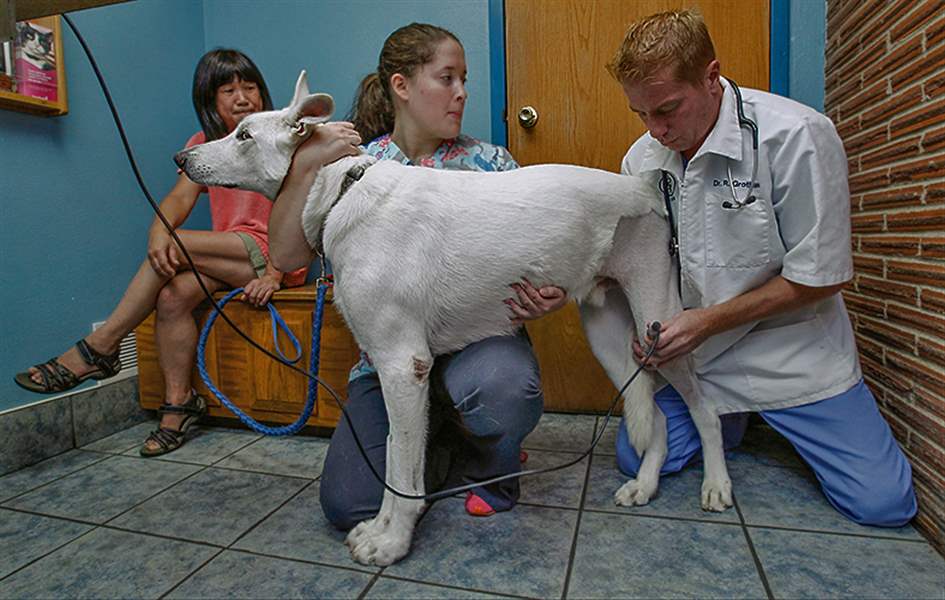
CRITTER CARE
Lasers give pets in painwaves of relief, healing
Treatment scientifically proven, vets say
9/16/2013
Tomoko Pax, left, of Sylvania watches as Dr. Roger Grothaus uses a cold laser probe on the knee of Kanga, a 2-year-old German shepherd mix, at the Reynolds Road Animal Hospital in Toledo.
THE BLADE/LORI KING
Buy This Image

Tomoko Pax, left, of Sylvania watches as Dr. Roger Grothaus uses a cold laser probe on the knee of Kanga, a 2-year-old German shepherd mix, at the Reynolds Road Animal Hospital in Toledo.
Veterinary medicine is borrowing from human medicine in the use of cold lasers to treat inflammation and help wounds heal faster.
Dr. Roger Grothaus of Reynolds Road Animal Hospital in Toledo uses the laser on many types of cases.
The laser accelerates the natural healing process through photo-bio-modulation, according to LiteCure, the makers of one veterinary laser. It is effective in treating chronic conditions, acute conditions, and postsurgical pain and inflammation.
It is worth considering as a treatment because it provides scientifically proven, nonpharmacologic pain relief and can be effective for difficult conditions, or as an alternative to surgery, the company said. Treatment is fast and noninvasive.
The beneficial effects of laser light on tissue were first recognized almost 40 years ago, according to LiteCure. Since then, thousands of studies have documented the positive effects laser light has on different types of cells, tissue, and disorders.
Dr. Grothaus recently used the laser, which is delivered via a hand piece, to treat Deuce, a 15-year-old English springer spaniel with cuts on three of his paws.
Deuce’s owner, Alan Kimpel of Perrysburg, held the dog while the laser was applied for about five minutes per paw.
“This case is perfect because we are dealing with superficial abrasions,” Dr. Grothaus said.
Deuce, who suffered the injury when running down a rocky hill, had already had one laser treatment for the injury and Mr. Kimpel said he was “amazed” by the results. “You can’t even tell they are bothering him anymore,” he said.
The brown-and-white dog relaxed during the treatment and didn’t seem to notice what was being done to him. Dogs usually are given “doggle” sunglasses to wear to protect their eyes from the light. Dr. Grothaus also normally wears protective glasses.

According to LiteCure, pets feel a gentle and soothing warmth. As the laser is administered, many pets will relax, much like you would experience during a good massage.
The almost immediate relief of pain will allow your pet to be comfortable and any anxiety that your pet initially experienced will dissipate.
Another of Dr. Grothaus’ patients was being treated with the laser to help promote postsurgical healing.
Kanga, a 2-year-old white German shepherd mix, tore his ACL while he was chasing a goose, said his owner, Tomoko Pax of Sylvania.
The 108-pound dog had surgery nine days before the laser treatment and received his first treatment right after surgery, Dr. Grothaus said. Kanga couldn’t wear the “doggles” because they were too small for him.
With Deuce, Dr. Grothaus used a surface probe while Kanga’s ailment required a deeper probe, he said.
The lasers cost $10,000 to $30,000 for vets to purchase. At Reynolds Road Animal Hospital, clients are charged $12 per laser treatment.
“We’ve had it about a year and I’m really happy with the results we’ve seen,” Dr. Grothaus said. “I don’t even care if we recoup the cost of it. I’m just happy to see patients healing faster.”
Contact Tanya Irwin at: tirwin@theblade.com, 419-724-6066, or on Twitter at @TanyaIrwin.